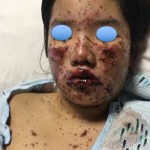On this Mnemonic Monday, we challenge you to remember major causes of drug-induced Stevens-Johnson Syndrome (SJS) with the following mnemonic:
SANA
Sulfonamides
Anticonvulsants
NSAIDs
Allopurinol
Click HERE to print your mnemonic card.
Study More!
Need a refresher on Stevens-Johnson Syndrome? Check out the following pages of your 2019 Derm In-Review Study Guide:
Stevens-Johnson Syndrome: 124, 299, 329, 335, 398, 408, 454
Don’t have a copy? Sign up for Derm In-Review and download the digital version here.
Further Reading
Check out the following articles published in the Journal of Drugs in Dermatology (JDD):
Recommendations for Prevention of Drug Re-Exposure in Toxic Epidermal Necrolysis
Drug re-exposure resulting in Stevens-Johnson syndrome (SJS) or toxic epidermal necrolysis (TEN) is a rare phenomenon and has scarcely been reported. With an aging population, polypharmacy, and a lack of a unified electronic medical record, standard recommendations to prevent or minimize the risk of re-exposure are necessary. We identified five patients, with diagnosis confirmed SJS/TEN, and determined the clinical characteristics and contributing risk factors leading to re-exposure. Polypharmacy, multiple prescribers, advanced age, medical illiteracy, retention of discontinued medications and self-prescribing all contributed to re-exposure in this cohort of patients. This case series demonstrates the potentially deadly effect of drug re-exposure, and the need for both streamlined and integrated medication allergy documentation systems.
Read the full article here. Don’t have a JDD subscription? Subscribe here.
J Drugs Dermatol. 2019;18(10):1049-1052.
Early Treatment With Nonsucrose Intravenous Immunoglobulin in a Burn Unit Reduces Toxic Epidermal Necrolysis Mortality
BACKGROUND: Intravenous immunoglobulin (IVIG) can be used to treat potentially deadly toxic epidermal necrolysis (TEN), milder Stevens Johnson Syndrome (SJS) and intermediate TEN/SJS overlap. Some formularies now deny IVIG for TEN based on the EuroSCAR TEN/SJS study that reported a nonsignificant trend toward increased mortality in 75 IVIG-treated TEN/SJS patients; of note the IVIG patients had more TEN and less SJS than patients in other treatment arms. EuroSCAR data on mortality among the 25 IVIG-treated TEN patients, use of nonsucrose IVIG, and admission to specialized settings such as burn units was not disclosed. The impact of treatment setting (specialized unit vs general ward) on IVIG efficacy has not previously been studied.
OBJECTIVE: To evaluate efficacy of treating TEN with early nonsucrose IVIG in a burn unit.
METHODS: Data were retrospectively collected from 13 IVIG-treated TEN patients admitted to a burn unit over a 6-year period.
RESULTS: We report 0% mortality among 13 IVIG-treated TEN patients. Mortality was significantly lower than predicted by SCORTEN. Mortality was also significantly lower than the EuroSCAR groups receiving IVIG (P<.005), supportive care (P<.018), and corticosteroids only (P<.046).
CONCLUSION: TEN patients may benefit from early nonsucrose IVIG administered in burn units or other specialized settings.
Read the full article here. Don’t have a JDD subscription? Subscribe here.
J Drugs Dermatol. 2013;12(6):679-684.
Test your knowledge!
 This 20-year-old woman started lamotrigine 3 weeks ago. She takes no other medications and has no comorbid conditions. Her urine b-HCG is positive. Which of the following treatments has the theoretically lowest fetal risk?
This 20-year-old woman started lamotrigine 3 weeks ago. She takes no other medications and has no comorbid conditions. Her urine b-HCG is positive. Which of the following treatments has the theoretically lowest fetal risk?
A. Prednisone
B. IVIG
C. Etanercept
D. Cyclosporine
E. Rituximab
To find out the correct answer and read the explanation, click here.
Did you enjoy this mnemonic? You can find more here.
Brought to you by our brand partner Derm In-Review. A product of SanovaWorks.

